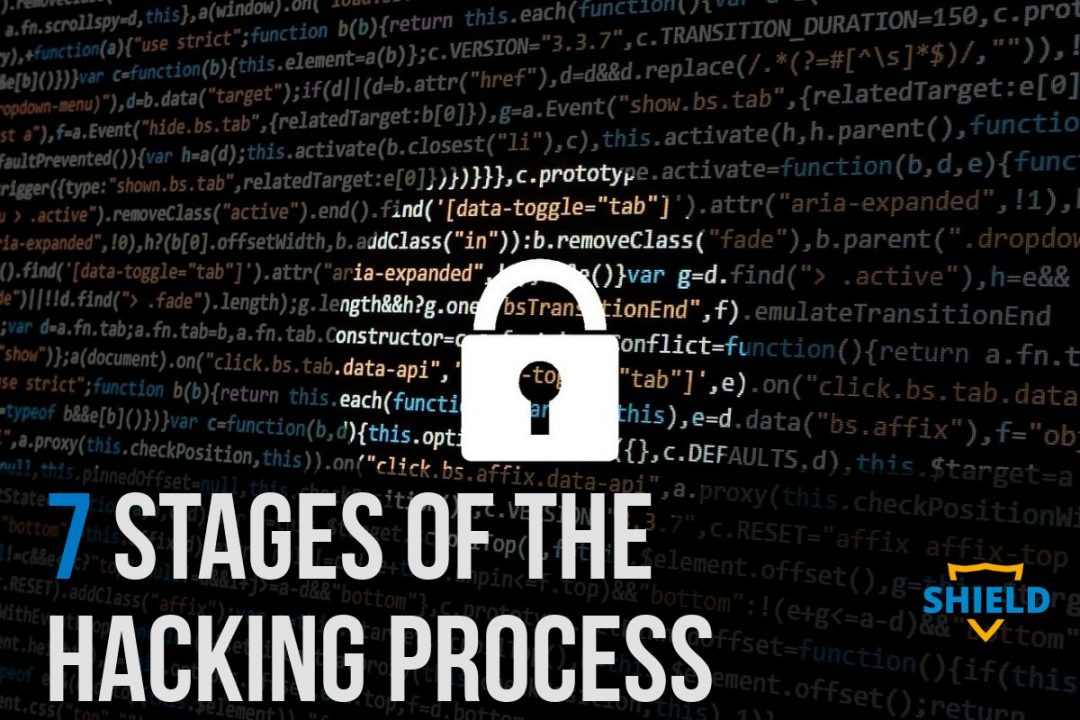
Advanced cyber attacks are monumentally meticulous efforts. The amount of planning and execution time it takes to carry out an attack can vary – but are you ready for this? These days, a good hacker can cozy up inside a network for upwards of 200 days on average before they’re discovered. In some cases, such as the headline Sony Pictures breach, hackers allegedly spent upwards of a year inside Sony’s network without being detected.
That’s a substantial amount of time for an individual or a collective to have access to your private data, eavesdrop on confidential communications, or map out their assault on your network. All cyber attacks vary a little bit – but all require meticulous planning and razor-sharp execution. They may all need different things to succeed, but the one thing they all have in common is the need to remain undetected until the last moment.
In this guide, we’re outlining the 7 stages of the hacking process and showing you how Shield’s Data Protection and Network Security Solutions intervene along the way.
 Reconnaissance
Reconnaissance
Like attacks of all types, hackers must first identify a vulnerable target and meticulously study how to best expose and infiltrate their attack. The target can be anyone within an organization where phishing emails are common starting points as an effective means of setting loose harmful malware.
This happens by monitoring inbound and outbound network activity. Liken the reconnaissance stage to casing out a bank – the attacker takes their time to gain a sense of the everyday in-and-out traffic to understand how best to approach a weakness.
Shield Solution:
- Shield-BGProtect: Alerts on data detours so clients know they are surveillance targets.
- Shield-SDA: Hackers can’t hack what they can’t see! This product hides the network from the Internet.
 Network Intrusion
Network Intrusion
Once hackers successfully identify a suitable target, the next step is scanning the network for an entry point, sometimes taking months as they search for weaknesses and easy entrances.
This can be in either the form of technology breaches or human-error. Consider that in cases of human error, active cyber solutions can prevent malicious code from running – even if you click on things you shouldn’t accidentally.
Shield Solution:
- Shield-SDA: Users are authorized before getting access only to their requested application or service. The whole network is never exposed.
- Shield-Gate: Blocks code embedded in data from entering the network.
 Obtain Credentials
Obtain Credentials
Here, the attacker begins to mine for successful information. Once the hacker has tapped into a loophole or found a suitable gap in the security technology, they may begin steps to gain access and heightened privileges, making it easier for them to navigate the system to breach information through legitimate logins and access. Liken this stage to the hacker gaining the proverbial keys to the kingdom.
Internet-available tools help attackers to hijack credentials and gain access to any system on the network in question that’s accessible via their stolen admin account. Once hackers succeed in obtaining credentials, it gets tougher to protect against an upcoming attack – they effectively own the system and have taken over from the inside.
Shield Solution:
- Shield-SDE: Complaint messaging platform that prevents data leakage.
- Shield-CyBot: Identifies systems and business processes that could leak credentials etc.
 Establish Backdoor
Establish Backdoor
The breach has been made; hackers are now busy building a kind of pseudo tunnel to hijack your data and mine information over time undetected. Organizations need to prevent breaches at all costs – and it starts by knowing when someone has tapped into your vein of information discreetly with plans to exploit it over time.
In the eyes of the attacker, the ideal situation is always to remain undetected – like a parasite impacting you over time. At this stage, attackers can likely also change or erase files on infiltrated networks.
Shield Solution:
Shield-CyBot: Scans the entire network for vulnerabilities that hackers could exploit to create a backdoor.
Shield-SDE: Advanced data exchange broker for email, web, mobile, and Fax. All Data is secured and encrypted; only authorized personnel to have access to view or share it.
 Maintain Presence
Maintain Presence
The attacker has gained access to the targeted network, abducted credentials, and now they’re going to want to maintain a silent presence inside. In the attacker’s mind, exploitation of a system has some form of value, whether that be monetary or otherwise. In these cases the attacker finds a home exploiting the data, or digging in further to prepare for further manipulation.
Shield Solution:
- Shield-SDA: Internal network, data, and apps are never exposed to the Internet. Makes it nearly impossible for hackers to breach the perimeter.
- Shield-CyBot: Continuous Machine Learning based hacker that patrols the network for exploitable vulnerabilities.
 Install Tools & Code
Install Tools & Code
The attack installs malicious code, keyloggers and other software to exploit the compromised system and networks. To accomplish these goals, attackers may seek to install malicious tools and code that allow them to come and go undetected, as frequently as they please.
At this point in the attack, it’s like a Domino effect, or like leaving something in your fridge too long – it’s only going to grow into a bigger problem.
Shield Solution:
- Shield-CyBot: Helps lock down the network before a hacker strikes!
- Shield-Gate: Prevents code from even entering the network. Scans email, web & APIs for code hidden inside data streams.
 Hack & Steal Data
Hack & Steal Data
This is when things can become really wild, and when hackers may be able to change the functionality of hardware or completely disable a network altogether.
With more advanced software, scripts and tools installed the max exploitation is achieved. Collecting data, running freely on the network or having avenues to exploit further. This continues to progress the problem like the symptoms of a cold. At this point, it’s very difficult for a compromised network to defend itself because it’s already lost control of the environment to the hacking party.
Shield Solution:
- Shield-SDE: Internal users can’t share or view data they don’t have permission to access. Data is encrypted.
- Shield-SDA: Can’t steal what you can’t hack! Shield-SDA establishes a Zero-Trust Network boundary, allowing access only after assessing trust.
—–
Innovative cybersecurity solutions don’t wait around until hackers get what they want. Intuitive and active cybersecurity solutions like Shield’s vast array of products work to smoke out system vulnerabilities and detect unwanted activity. Contact us today about your network security concerns, and we’ll work together to protect against the various stages of hacker infiltration.
